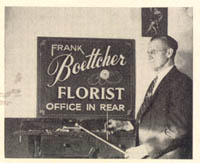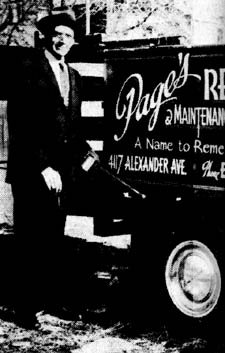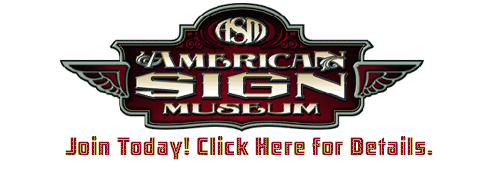|
|
He's Been Lettering Trucks for 50 Years
by J. David Paisley (J. David Paisley Co., St. Louis, MO)
from Signs of the Times magazine; March, 1962 issue, pp. 104, 128-129

Fifty years ago practically all truck lettering was on horse drawn wagons. There were very few "horseless trucks" and the people who owned them "wouldn't spoil their beauty" with advertising. E.C. Matthews left his father's ranch and went to Colorado Springs early in February 1912, to become an artist or sign painter: willing to try whichever would give him a start. He soon found that there was more demand for lettering than for his drawings. He had never seen a sign painter at work until the previous summer, when he saw a Mr. Isbell doing gold leaf window lettering in a local bank. Mr. Isbell was a small town banker himself, as well as an expert sign painter, who put the fine gold leaf signs on many banks in Colorado.
There were three small sign shops in Colorado Springs, under the names of Bancroft, Custer and Hawk. Young Matthews helped them all a little, when they had anything he could do, but he says that they helped him more than he could help them.
Mr. Bancroft was the most successful of those signmen and also had quite a reputation as a landscape painter. So he took an interest in this "gawky" teenager and his drawings. Mr. Custer was an old "wall dog" who had quit the high work and opened a one-man shop in this health resort town. He couldn't get accustomed to soft brushes and used to letter windows, showcards and everything with his fitches. Nevertheless he was a very good sign painter. Mr. Hawk specialized in cards and banners, had the first airbrush in that part of the country and did some very artistic work. These men shortened the young fellow's name to "Matt."
 |
Lettered first trucks in 1912 In May 1912, he lettered his first trucks: two big horse drawn wagons for Wandell & Lowe Transfer Co. The firm is still in business, and one of the sign shops is still operating although the original owners have died. He moved to St. Louis in February 1916, and the first things to attract his attention to here were the beautiful gold leaf window signs by Gus Fennerty. When he visited that shop he found that those unusual jobs were done by Alf Becker, who was working for Mr. Fennerty. Thus began a friendship that lasted over 40 years.
|
During the winters of '16 and '17, Mr. Matthews attended the Lockwood Art School in Kalamazoo and then worked for an advertising agency and an engraving house. He also did some cartooning, but he soon gave up the small artwork to return to signs and truck lettering.
In the spring of 1920 he went to a job of truck lettering with a large auto painting company in New York City. Most of those trucks were done in gold or aluminum leaf, often with elaborate scrolls, and some included pictorial work. All this was done in Japan color, and he usually worked from one to three days on each truck. Then the following day the job was given a finish coat of varnish.
In those days the owner often laid the trucks off for a week to have them painted, lettered, striped and varnished. Such lettering was charged for by the foot. It was the usual shop custom to employ an extended style of lettering, so that the job would add up to plenty of feet. Practically all truck lettering was outlined at that time, so the signmen really earned their money. Wages were about ten dollars per day.
In New York, Mr. Matthews' first book How to Paint Signs and Sho' Cards was published. It went through many editions and was on the market from 1920 to 1940. Quite a few of today's signmen got their start through that little volume. $15 a day wages 40 years ago.
"Matt" worked in New York for over a year, and then moved on to Los Angeles another year, where the wages were sometimes as high as $15 per day. He also worked in many of the big cities between those two places. He specially observed the finest work everywhere and always claimed that Alf Becker was the best signman in the country, but Mr. Becker modestly disclaimed the honor.
Among other things, Mr. Matthews wrote books on cartooning, commercial art, illustrating, landscape painting and many other subjects. His largest cartoon book How To Draw Funny Pictures was illustrated by Zim, the famous old-time cartoonist, who contributed many articles and illustrations to Signs of the Times in the '20s and early '30s.
In 1928 Mr. Matthews revised and rewrote the old Chas. J. Strong Sign and Show Card Course for the Detroit School of Lettering and furnished them with many new illustrations. He was always ready to help the beginner and not one to keep a good idea secret.
Still does signs occasionally
"Matt" is still an active man, but his main interest now is a big, new
book he is working on, about old days in the West. He has recently retired,
but I found him lettering a small prestwood sign. He occasionally "knocks
out" a truck or small boards for old customers but tried to devote most
of his time to writing.
He says that very few auto trucks were lettered before World War I. It was mostly wagon lettering in the old days. But, since then, truck owners have come to appreciate the value of such advertising. He considers it one of the bright spots in the future of sign painting.
Besides writing books and lettering trucks, Mr. Matthews is known for his many innovations in sign painting technique. Before World War I the old signmen considered it "unethical" to trim windows lettering with a razor blade. Everything had to be done with a brush. "Matt" demonstrated the easier method on gold leaf and other glass signs wherever he worked, and others soon adopted the idea.
He pioneered the lacquer system, beginning in 1926 and some of his articles on the subject were published in Signs of the Times ("Why Lacquer is Coming to the Front"). He also found a way to mix aluminum, or gold bronze, with clear lacquer for inside window lettering. He says that the material works smoothly, dries quicker than varnish or gold size, is more durable and has better gloss; also the shades or background colors never "strike-through."
Used stock patterns for trucks
During World War II there were so many trucks to letter that he started
using stock pounce patterns, consisting of guidelines only. He made up
over 20 stock designs that would fit almost any wording on doors and panels.
This saved the time otherwise spent in measuring and snapping lines. "Matt"
lettered as many as six small trucks a day: all with different layouts
and lettering. He was always experimenting with paints and colors, to
find simpler ways of doing things. During those 50 years he has lettered
thousands of trucks, but he has no record of exactly how many there were.
Mr. Matthews knew many of the other old time signpainters and showcard
writers, including John Ohnimus, Val Costello, Al Imelli, King Cole, G.
W. Atkinson, J. G. Bissell and many more. He also carried on a friendly
correspondence with Frank H. Atkinson, H.C. Martin and many others who
were well known over the years.
For almost 35 out of those 50 years he has been in St. Louis. Many of the old friends are gone. He humorously recalls the big nickel beers and free lunches of yesteryear. The things he really misses are the lively show district that once occupied a big downtown area and, most of all, the deep, melodious steam boat whistles, so often heard for miles back of the river, in those pre-war days of 1916.
Home | News | Exhibits | Events | Links | Talk | FAQ | Contact Us
